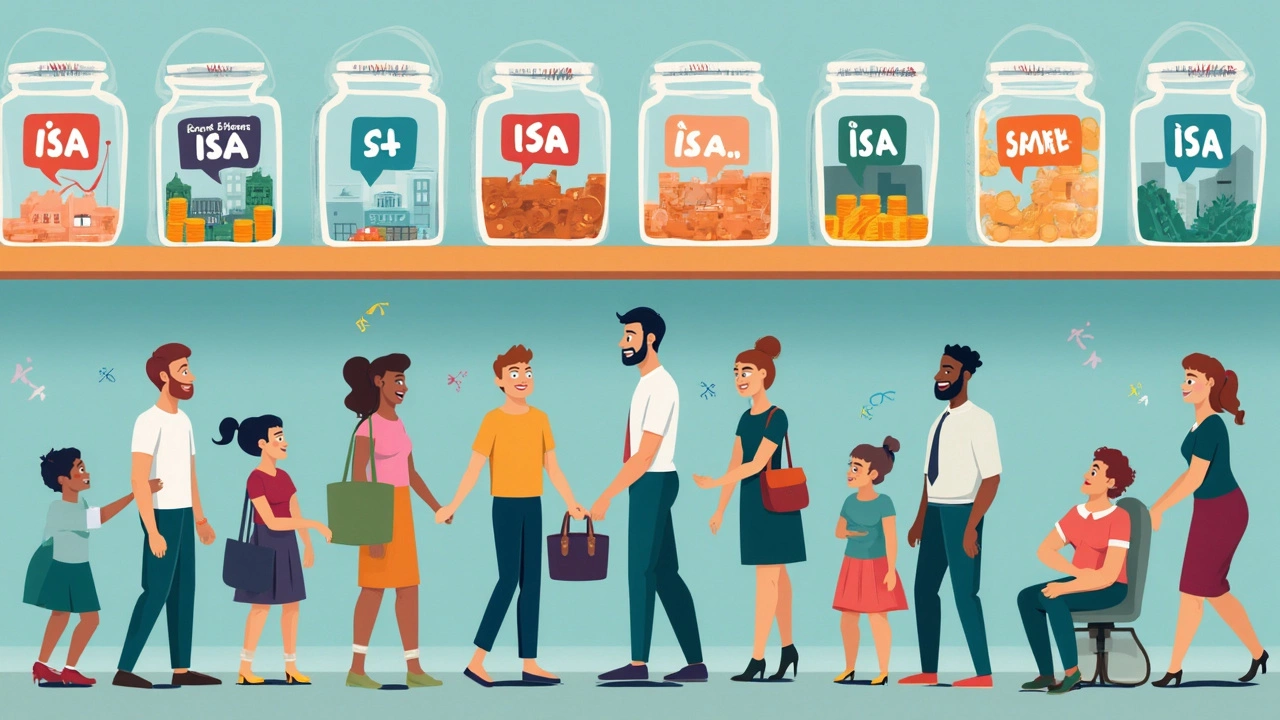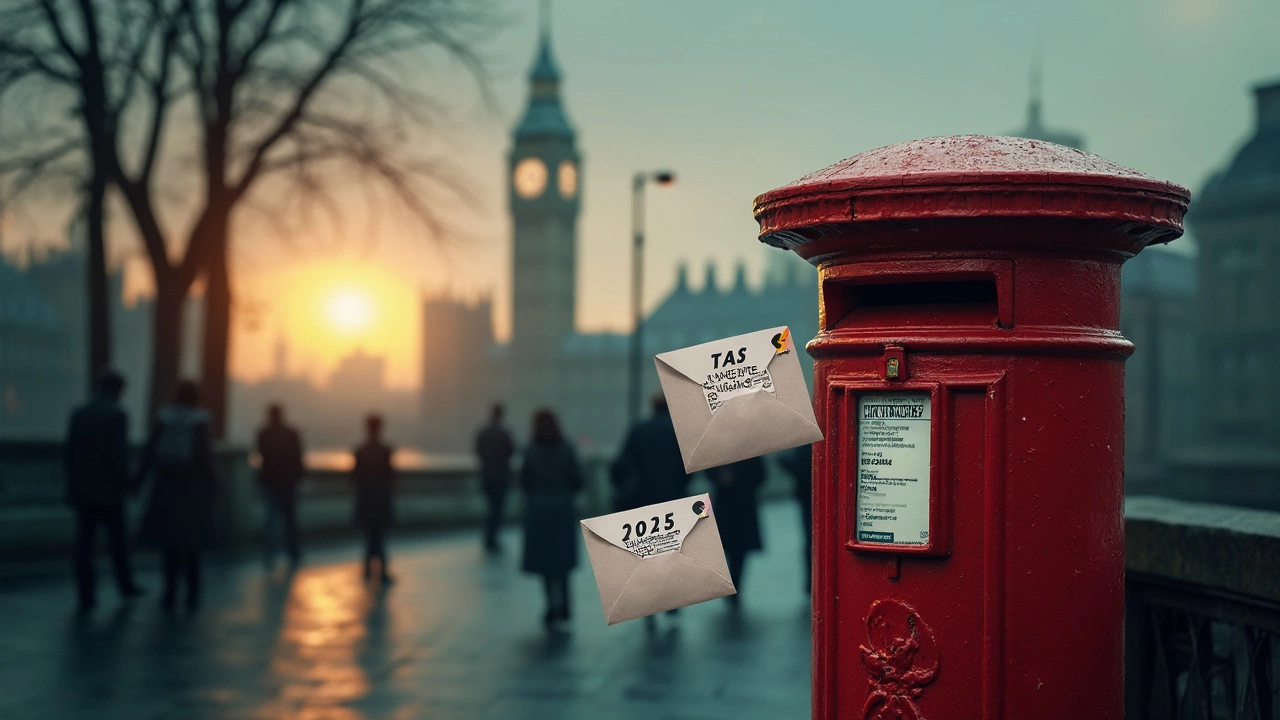Ever feel lost when someone mentions "ISA accounts" at the pub? You're not alone. ISAs are just savings or investment accounts with a massive bonus—you don’t pay tax on the interest or the gains. But picking the best one? That’s the tricky bit. There's a pile to choose from, and the right option depends on what you want your money to do.
With the 2025 ISA updates, rules are a little friendlier, but the basics haven’t changed: you get a set allowance each year (£20,000 for adults), and you can spread it out across different types or dump it all in one. Some ISAs are instant access; others lock away your money for longer. If you’re aiming for a house deposit, a rainy day fund, or just want your savings to grow quietly in the background, there’s a good fit out there. The trouble is, most people stick with what’s familiar and miss out on better deals or bigger returns.
- What’s an ISA and why bother?
- Cash ISAs vs Stocks & Shares ISAs
- Don’t Ignore the Lifetime and Innovative Finance ISAs
- How to Pick the Best ISA for You
- Mistakes People Make (and How to Dodge Them)
What’s an ISA and why bother?
If you live in the UK and want to save or invest money without giving some of it to the taxman, you need to look at ISA accounts. ISA stands for Individual Savings Account. They’re special because you don’t pay tax on the interest, dividends, or capital gains you earn—unlike with a regular savings or investment account. That can make a huge difference if you save up over several years.
Every tax year, there’s a limit to how much you can stash in ISAs. For 2025, the allowance is £20,000. You can stick it all in one ISA, or split it between different types (like cash, stocks and shares, or even innovative finance ISAs—it’s up to you). And your allowance resets every April, so if you don’t use it, you lose it. No rolling over.
There are four main types:
- Cash ISA: Works like a regular savings account, just with tax-free interest.
- Stocks & Shares ISA: Lets you invest in shares, funds and bonds where any growth stays tax-free.
- Lifetime ISA: Made for first-time home buyers and retirement savings (with a government bonus on top).
- Innovative Finance ISA: For peer-to-peer lending and other alternative investments.
The main reason to bother? The tax perks. Let’s say you had £10,000 in a savings account earning 4%, you’d get £400 interest. At the basic tax rate, you might pay 20% on it, losing £80 straight away to tax. An ISA keeps that money in your pocket. And if you invest bigger amounts or get bigger returns, the savings just grow.
| ISA Type | Who it suits | 2025 Allowance |
|---|---|---|
| Cash ISA | Low-risk savers | £20,000 |
| Stocks & Shares ISA | Potential for growth | £20,000 |
| Lifetime ISA | First-time buyers/retirement | £4,000 (part of £20k total) |
| Innovative Finance ISA | P2P investors | £20,000 |
The Financial Conduct Authority sums it up pretty well:
“ISAs are a simple way for people to save and invest tax efficiently, helping them to grow their money over the long term.”
ISAs are flexible, too. If you want to take money out and put it back in (called ‘flexible ISAs’), some providers let you do that without eating into your annual limit. Handy if you dip into savings for car repairs, then top up again later.
So, if you haven’t got an ISA, you’re basically letting the taxman have a little bonus every year. Why give up free money?
Cash ISAs vs Stocks & Shares ISAs
If you boil things down, cash ISA accounts work like your regular savings account—just with zero tax on the interest you earn. You pop your money in, and it stays safe. With rates inching above 4% from the top providers in 2025, cash ISAs are finally decent again after years of rock-bottom returns. They’re also usually covered by the FSCS, up to £85,000, so your cash stays protected if the bank goes under. Perfect for short-term goals, emergency funds, or if you just want zero risk. But let’s be honest: the returns still barely keep up with inflation most years.
Now, stocks and shares ISAs let you invest your cash in things like shares, bonds, or funds—still tax-free on any growth, dividends, or profits. Over ten years, the stock market has easily beaten the typical cash ISA. The catch? There's always some risk. If markets wobble, your savings can drop in value, at least in the short run. But the upside is hard to ignore. According to the UK Investment Association, average annual returns for balanced investment funds were around 5-8% over the past decade, while cash ISAs barely managed 1-2% most of the time.
So, which is better? Here’s a quick snapshot:
| Feature | Cash ISA | Stocks and Shares ISA |
|---|---|---|
| Risk | Very low | Higher—goes up and down |
| Potential returns | Low (currently 4-5% best) | Medium/High (historically 5-8%) |
| Access to money | Easy (sometimes instant) | Could take a few days to sell investments |
| Best for | Short-term savings, safety | Long-term growth (5+ years) |
The real trick is matching your ISA to your goal. If you need the money soon or don’t want to lose sleep over market swings, stick with a cash ISA. But if you’ve got time on your side and want to beat inflation, a stocks and shares ISA is your friend. Some folks even split their allowance between both types for a bit of safety and a shot at bigger gains. You aren’t locked in unless you pick a fixed-rate cash ISA, so it’s more flexible than most people think.

Don’t Ignore the Lifetime and Innovative Finance ISAs
If you only look at regular ISA accounts, you’re missing some clever tools. Lifetime ISAs and Innovative Finance ISAs aren’t for everyone, but when they fit your plans, they can easily outshine the basics.
The Lifetime ISA (LISA) is gold if you’re between 18 and 39 and thinking about your first home or retirement. You can save up to £4,000 each year, and the government chucks in a 25% bonus on top—so that’s up to £1,000 free every year. The catch? You can only use it for buying your first home (up to £450,000), or take it at age 60 or older. Withdraw early for anything else, and you lose the bonus plus pay a penalty. It’s perfect if you’ve got a long-term target, but lousy if you might need the cash quickly.
The Innovative Finance ISA (IFISA) flies under the radar, but it’s worth a look for bigger risk-takers. Instead of sticking your money in banks or shares, you’re lending to other people or businesses through peer-to-peer platforms. The interest rates are often much higher than cash ISAs—sometimes 5-8% or more if things go well. But, and it’s a biggie, there’s no safety net (like the FSCS protection up to £85,000 for savings). If a borrower can’t pay you back, you wear the loss.
| Type | Annual Limit (2025) | Gov. Bonus | Main Use |
|---|---|---|---|
| Lifetime ISA | £4,000 | Yes, 25% | First home (<£450K) or retirement |
| Innovative Finance ISA | £20,000 | No | Peer-to-peer lending |
One tip: you can mix your ISA allowance between types, but the total can’t go over £20,000 for the tax year. So you could put £4,000 in a LISA and the rest elsewhere, if it fits your goals.
It’s easy to ignore these options, but that could be money left on the table. If you’re planning to buy a house or don’t want your full savings in a Cash ISA or Stocks & Shares ISA, check these two out. Just be clear about the risks, read the small print, and don’t let a high interest rate distract you from what the account is really for.
How to Pick the Best ISA for You
Before you overthink things, start with one question: what do you need your money to do? ISAs aren’t one-size-fits-all, and choosing the best ISA account depends on your savings goal, time frame, and how much risk you’ll tolerate.
If you want zero risks and easy access, a cash ISA makes sense. It’s like a regular savings account but tax-free. Top high street deals in May 2025 are around 4.8% fixed for a year, which beats leaving your money in a no-interest account. Remember, most instant-access cash ISAs offer lower rates, so check the terms before you sign up.
If you’re thinking longer term—say, five years or more—consider a stocks and shares ISA. These accounts let your money grow by investing in funds, shares, or bonds. You could get average returns of 5-8% a year (over the long haul), though nothing's guaranteed and you need the patience to ride out the bumps.
- Saving for your first home or retirement? A Lifetime ISA (LISA) is hard to beat—up to £4,000 a year, and the government adds a 25% bonus (that’s free money, up to £1,000 per year).
- Want to lend out money to get higher returns? Look into Innovative Finance ISAs, but know that peer-to-peer lending comes with higher risks, and some providers have strict rules.
Here’s a quick comparison of what you can stash in each ISA (all stats current for 2025):
| ISA Type | Max Allowance | Typical Use | Risk |
|---|---|---|---|
| Cash ISA | £20,000 | Rainy day savings | Low |
| Stocks & Shares ISA | £20,000 | Long-term investing | Medium–High |
| Lifetime ISA | £4,000 | First home or retirement | Low–Medium |
| Innovative Finance ISA | £20,000 | P2P investing | High |
Another thing—watch out for minimum deposits or withdrawal rules. Some ISA accounts don’t let you take money out easily without losing interest, which can trip people up if they haven’t read the small print.
Here’s a quick checklist to make choosing easier:
- Figure out if you need the cash soon or can lock it away.
- Check interest rates, fees, and any government bonuses (especially for LISAs).
- Compare several providers before sticking to your own bank—you might find much better deals online or with new app-based banks.
- If you’re splitting your allowance, make sure the total across all ISA accounts doesn’t go over £20,000 per tax year.
- If you’re thinking about a stocks and shares ISA, look for simple fees and a good range of funds, not just shiny adverts.
It’s not about the “fanciest” account, but the one that gets you to your goal fastest, with as little stress as possible. A little time spent shopping around could mean a lot more cash in your pocket in a year or two.

Mistakes People Make (and How to Dodge Them)
Believe it or not, people mess up their ISA accounts all the time—and some of these slip-ups can cost you real money. Here’s a rundown of what regularly trips people up, and some simple tricks to stay out of trouble.
- Missing the allowance deadline: Every tax year you get your £20,000 allowance, but if you don’t use it before 5 April, it’s gone for good. Loads of people leave it too late and lose the chance to top up.
- Overfunding across providers: You can open as many ISAs as you like, but in each tax year, you can only put new money into one of each type (one Cash, one Stocks & Shares, etc.). Dumping money into two Cash ISAs in the same year? That’s a classic mistake people make.
- Not shopping around: Sticking with your bank’s Cash ISA might seem easy, but you’ll often get interest rates under 2%. Some online ISAs are paying over 4.5% right now. That’s money you’re just leaving on the table if you never switch.
- Forgetting transfer rules: You can move your ISA accounts between providers to chase higher rates or better service, but you have to use the official transfer process. Taking the cash out yourself first kills your tax-free status.
- Choosing the wrong ISA type: Lots of savers just pick a cash ISA because it’s what their parents did. But if you’ve got a long time before you need the money, you might do way better with a stocks and shares ISA for higher returns, even with the risk.
- Using Lifetime ISAs carelessly: You can only use funds from a Lifetime ISA for your first home (up to £450,000) or retirement after 60. Taking the money out for anything else means a 25% penalty—which actually eats into your contributions, not just your gains.
The FCA reported last year that about 15% of ISA holders believed they had lost their tax-free status after a transfer just because they didn’t follow the rules. That’s a painful way to learn a lesson. Here’s a quick reference table with some classic do’s and don’ts:
| Mistake | How to Dodge It |
|---|---|
| Opening two Cash ISAs in one year | Stick to one new Cash ISA a year for new money |
| Missing the tax year deadline | Set a reminder to use your allowance before 5 April |
| Transferring by withdrawing funds | Always request an ISA transfer from your new provider |
| Not checking the small print | Read the terms for withdrawal charges or fixed-rate penalties |
| Leaving cash in poor interest ISAs | Shop around yearly for the best cash ISA rates |
Bottom line: check the rules, keep an eye on your rates, and use your ISA allowance with a bit of thought. That alone can boost your savings more than you’d think.
